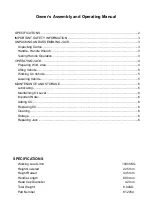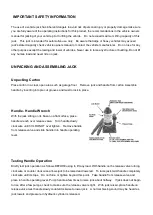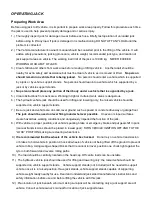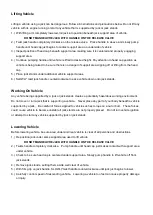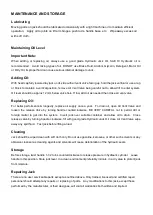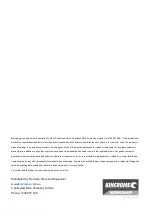
OPERATING JACK
Preparing Work Area
Before using jack to lift vehicle, it is important to prepare work area properly. Follow this procedure each time
the jack is used to help prevent property damage and or serious injury.
1.) Thoroughly inspect jack for damage or wear before each use. Briefly test operation of unloaded jack
before using to lift any load. If jack is damaged or is malfunctioning DO NOT LIFT ANY LOAD until the
problem is corrected.
2.) The Vehicle manufacturer’s owner’s manual should be consulted prior to the lifting of the vehicle. It will
advise safety precautions, jacking procedure, vehicle weight, recommended jack type, and location of
jack support areas on vehicle. The working load limit of the jack is 10,000 kg. NEVER EXCEED
WORKING LOAD LIMIT OF JACK.
3.) Clear children and others from work area before moving or lifting vehicle. Another adult should be
nearby for extra safety and assistance but must be clear of vehicle as it is moved or lifted.
No person
should remain in a vehicle that is being jacked
. No person should enter a vehicle which is supported
by a jack or by vehicle support stands. No person should lean into a vehicle which is supported by a
jack or by vehicle support stands.
4.)
No person should place any portion of their body under a vehicle that is supported by a jack
.
5.) Clear obstructions from work area. Working in tight or cluttered work areas is dangerous.
6.) The hydraulic vehicle jack should be used for lifting and lowering only; the raised vehicle should be
supported on vehicle support stands.
7.) Be sure jack and vehicle are on solid, level ground such as paved or concrete driveway or garage floor.
The jack should be used on level firm ground wherever possible
. Uneven or sloped surfaces
create hazardous working conditions and dangerously impeded the function of the jack.
8.) With vehicle in proper position, set vehicle’s parking brake or emergency brake and put gearshift in park
(manual transmissions should be placed in lowest gear). TURN VEHICLE IGNITION OFF AND TO THE
“LOCK” POSITION making sure steering wheel locks.
9.)
It is recommended that the wheels of the vehicle be chocked
. Do not rely on vehicle transmission
or brakes to hold vehicle in position. Chock all wheels of vehicle not being lifted off the ground to prevent
vehicle rolling. Using wedge-shaped blocks that tire cannot roll over, position one chock tight against the
tyre in both forward and reverse rolling paths.
10.) The load should be centrally located on the head cap. Off centre loads can be unstable.
11.) The hydraulic vehicle jack should be used for lifting and lowering only; the raised vehicle should be
supported on vehicle support stands. Vehicle support stands (not included) will be needed to support
vehicle once it is in raised position. Have jack stands, vehicle support stands capable of supporting
vehicle weight ready nearby for use. Read and understand jack stand manufacturer’s instructions and
safety information before use and before lifting the vehicle with this jack.
12.) Plan location of jack beneath vehicle, making sure jack will be contacting only a jack support area of
vehicle. Consult vehicle owner’s manual for location of jack support areas.


